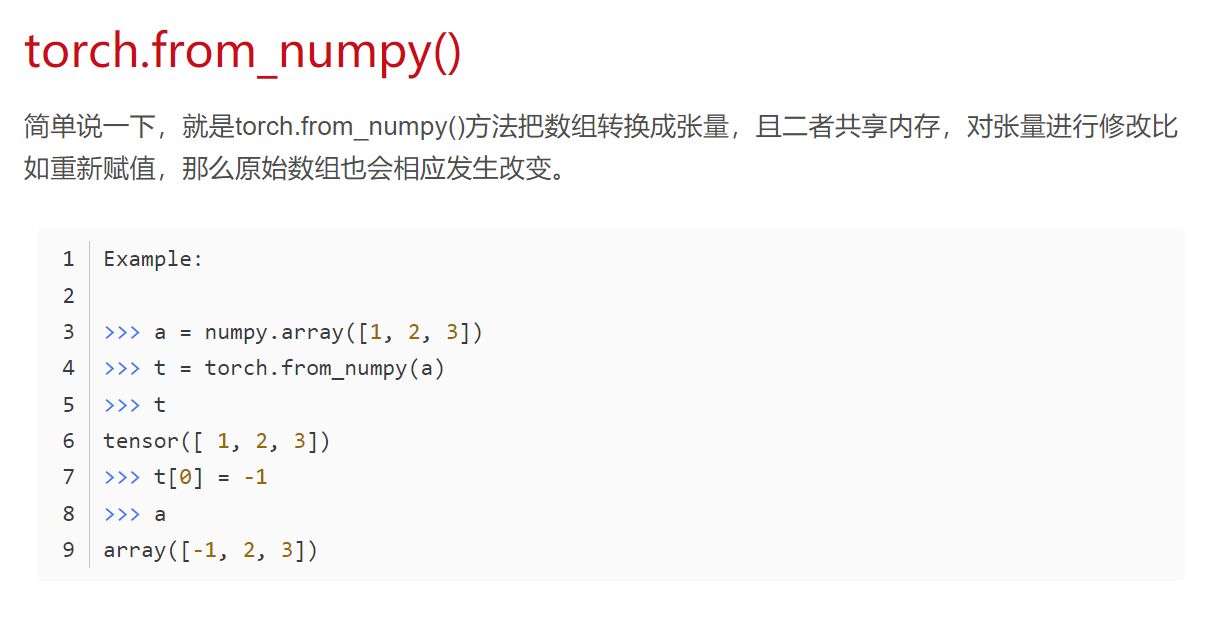我是靠谱客的博主 笑点低纸鹤,这篇文章主要介绍Tensorflow2.x 线性回归的实现1.自己学习笔记:2. tf.random_normal()函数:3. 遇到的问题:4. 整个代码:,现在分享给大家,希望可以做个参考。
目录
1.自己学习笔记:
2. tf.random_normal()函数:
3. 遇到的问题:
解决:tensorflow have no attribute enable_eager_execution()__yuki_-CSDN博客
(11条消息) torch.from_numpy()_NDHuaErFeiFei的博客-CSDN博客
TensorFlow随机值:tf.random_normal函数_w3cschool
4. 整个代码:
1.自己学习笔记:

线性回归的实现一般有以下操作:

这些都是神经网络建立的时候,常用的思路操作:读取数据,预处理数据,定义模型,定义损失函数,定义优化函数,训练函数,拟合分析...

调参:调节的是超参数。


学习书籍:《动手学习深度学习》
内容:线性回归
2. tf.random_normal()函数:

从正态分布中输出随机值.
参数:
- shape:一维整数张量或 Python 数组.输出张量的形状.
- mean:dtype 类型的0-D张量或 Python 值.正态分布的均值.
- stddev:dtype 类型的0-D张量或 Python 值.正态分布的标准差.
- dtype:输出的类型.
- seed:一个 Python 整数.用于为分发创建一个随机种子.查看 tf.set_random_seed 行为.
- name:操作的名称(可选).
3. 遇到的问题:
-
解决:tensorflow have no attribute enable_eager_execution()__yuki_-CSDN博客
-
(11条消息) torch.from_numpy()_NDHuaErFeiFei的博客-CSDN博客
-
TensorFlow随机值:tf.random_normal函数_w3cschool

在tf2.x中,与之类似的函数为:tf.constant (创建张量)
4. 整个代码:
%matplotlib inline
from IPython import display
from matplotlib import pyplot as pyplot
import tensorflow as tf
import random
import numpy as np
tf.compat.v1.enable_eager_execution()
#--------------------生成数据集操作---------------------
num_inputs = 2
num_examples = 1000
true_w = [2,-3.4]
true_b = 4.2
# 创建张量
#features = tf.constant(np.random.normal(0, 1, (num_examples,num_inputs)))
features = tf.random.normal(shape=(num_examples,num_inputs),stddev=1)
labels = true_w[0]*features[:,0]+true_w[1]*features[:,1]+true_b
labels += tf.random.normal(shape=(tf.shape(labels)),stddev=0.01)
def use_svg_display():
#用矢量图显示
display.set_matplotlib_formats('svg')
def set_figsize(figsize=(3.5,2.5)):
use_svg_display()
#设置图的尺寸
pyplot.rcParams['figure.figsize']=figsize
set_figsize()
pyplot.scatter(features[:,1].numpy(),labels.numpy(),1)
#--------------------读取数据操作---------------------
def data_iter(batch_size,features,labels):
num_examples=len(features)
indices=list(range(num_examples))
random.shuffle(indices)
for i in range(0,num_examples,batch_size):
#64位整型?与torch.LongTensor作用一致?
j=np.array(indices[i:min(i+batch_size,num_examples)])
yield tf.gather(features,j),tf.gather(labels,j)
batch_size=10
for X,y in data_iter(batch_size,features,labels):
print(X,y)
break
#tf.Variable :定义一个变量
#这里为什么不定义一个张量?要定义一个变量?
w=tf.Variable(tf.random.normal(shape=(num_inputs,1),mean=0,stddev=0.01))
b=tf.Variable(tf.zeros(shape=(1,)))
#定义了一个线性模型
def linreg(X,w,b):
return tf.matmul(X,w)+b
#定义一个损失函数:平方差函数
def squared_loss(y_hat,y):
return (y_hat-tf.reshape(y,shape=y_hat.shape))**2/2
#训练模型
#超参数配置
lr=0.03 #学习率
num_epochs=4 #迭代周期
net=linreg
loss=squared_loss
for epoch in range(num_epochs):
for X,y in data_iter(batch_size,features,labels):
with tf.GradientTape(persistent=True) as t:
t.watch([w,b])
l=loss(net(X,w,b),y)
sgd([w,b],l,t,lr,batch_size)
#这里为什么没有梯度清零?梯度清零有什么作用?
train_l=loss(net(features,w,b),labels)
print('epoch %d,loss %f'%(epoch+1,tf.reduce_mean(train_l).numpy()))
print(true_w)
print(true_b)结果:

最后
以上就是笑点低纸鹤最近收集整理的关于Tensorflow2.x 线性回归的实现1.自己学习笔记:2. tf.random_normal()函数:3. 遇到的问题:4. 整个代码:的全部内容,更多相关Tensorflow2.x内容请搜索靠谱客的其他文章。
本图文内容来源于网友提供,作为学习参考使用,或来自网络收集整理,版权属于原作者所有。








发表评论 取消回复